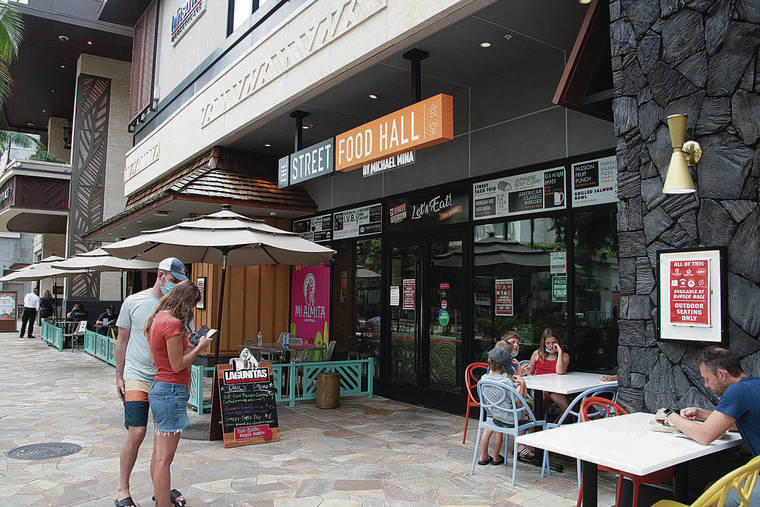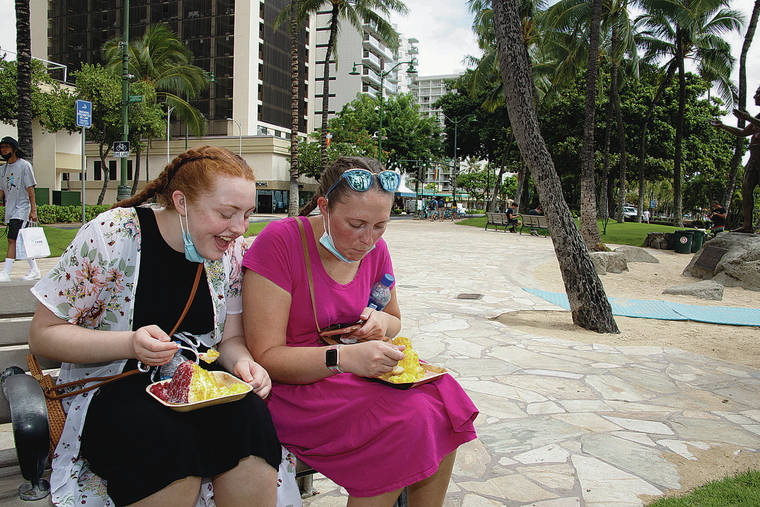Hawaii’s tourism reopening off to choppy start

CRAIG T. KOJIMA / CKOJIMA@STARADVERTISER.COM
The Street Food Hall by Michael Mina, located in the International Market Place in Waikiki, is closing permanently on Nov. 8. It features 11 food stations and currently employs 115 people.

CRAIG T. KOJIMA / CKOJIMA@STARADVERTISER.COM
Georgia visitors Ariana, left, and Carissa had a sweet snack Wednesday near the Duke Kahanamoku Statue in Waikiki.


The daily number of transpacific arrivals jumped when Hawaii started a pre-arrivals testing program to welcome travelers back. Now, one week into the state’s tourism reopening, visitor arrivals already have started leveling off.
The number of visitors coming for a vacation or to visit friends stood at 463 on Oct. 14, the day before Hawaii began its pre-arrivals testing program that gave travelers the opportunity to bypass a 14-day visitor quarantine. That number peaked at 5,124 on Saturday, but by Tuesday had dropped off more than 48% to 2,637.
Hawaii visitor industry leaders credit pent-up-demand for the better-than-expected traveler counts that came for the pre-arrivals program kickoff. Now, they say visitor arrivals are settling in closer to the 2,000 to 4,000 per day that the industry had expected, or even lower.
“The first few days were robust, but it’s been dropping off,” said Jack Richards, president and CEO of Pleasant Holidays, a Hawaii wholesale travel seller. “I would describe the reopening as choppy.”
The University of Hawaii Economic Research Organization has said it doesn’t expect to see meaningful economic recovery until the middle of next year, and an attenuated recovery period thereafter.
“The long-term expectations of recovery are so far out,” said Keith Vieira, principal of KV & Associates, Hospitality Consulting. “Most of the Hawaii hotels that have reopened are only running at about 15% to 20% occupancy, and that’s without all of the hotel supply reopened. Performance is still marginal at 50% hotel occupancy and that’s the best that most Hawaii hoteliers could even hope for right now.”
Don't miss out on what's happening!
Stay in touch with breaking news, as it happens, conveniently in your email inbox. It's FREE!
It’s a sign of the times that despite Hawaii’s tourism reopening, The Street food hall — celebrity chef Michael Mina’s casual dining concept in the International Market Place — announced Wednesday that it will close Nov. Opens in a new tab8 Opens in a new tab.
The Street — its full name is The Street Food Hall by Michael Mina — opened in 2017 in a 12,561- square-foot space on the ground floor of the marketplace. It is home to 11 food stations offering an international selection of cuisines. The Street currently employs some 115 people, according to a Worker Adjustment and Retraining Notification notice filed with the state in late September.
Scott Suemoto, sales and marketing director for the Mina Group, said the food hall was built around communal dining, a model unsustainable under social distancing restrictions.
The Street has been offering a consolidated takeout menu featuring bestsellers from the various stations, as well as items from Mina’s Stripsteak Waikiki, located upstairs in the marketplace. The Street was able to open for sit-down service between the two dining-room shutdowns, Suemoto said.
But the second shutdown put the food hall in a critical position, he said. “It made it kind of impossible to recover from the months and months and months of lost revenue.”
Mina also owns Mina’s Fish House in the Four Seasons Resort Oahu at Ko Olina. Suemoto said the company hopes to reopen both Stripsteak and Fish House soon.
Real estate analyst Stephany Sofos said lots of Hawaii businesses are “just hanging on” and for some the tourism reopening is too little too late.
“I’m sure by the timing of The Street’s closure that they were trying to make it work and just couldn’t do it anymore even,” Sofos said. “Waikiki was built to handle more than 10 million visitors and it’s going to be years before we even get close to that number again. It’s very sad, but I’m sure that we’re going to see many more businesses struggling — and some of them will have to give up.”
To be sure, Hilton Hawaiian Village, Hawaii’s single-largest hotel property, filed an amended WARN notice with the state on Oct. 15, the same day as Hawaii’s pre-arrivals testing program launch. Julie Walker, Hilton’s area director of human services, said in the notice that the company is potentially expanding furloughs past six months for 1,880 employees and as of Dec. 13 would begin permanently laying off 55 employees.
Walker said lockdown orders have interrupted travel and commerce substantially.
“For example, the state recently announced that travelers to Hawaii from outside the state must complete a COVID-19 test with negative results within 72 hours of traveling to Hawaii,” Walker said in the WARN notice. “If travelers do not comply with the testing requirement, they are required to quarantine for 14 days. Contrary to our expectations governmental orders continue to impose substantial limits on our operations at this location (such as social distancing guidelines, limits on large public gatherings, and capacity limitations).”
Ben Rafter, president and CEO of Springboard Hospitality, which has 35 hotels in Hawaii and eight other states, said he’s not expecting to see additional pickup for Hawaii’s hotel sector again until late December, early January at the soonest.
“Right now, Hawaii has the worst performing hotel markets in the United States,” Rafter said. “Hotels in the drive markets that have reopened like Napa, Calif.; Park City, Utah; and Jackson Hole, Wyo., are doing fine. Hotels in the urban markets are coming in about 30% occupancy. Once Hawaii reopens more, I think we’ll come in behind the drive markets, but ahead of the urban markets.”
In September, Oahu had a hotel occupancy of 21.3%, the lowest among the nation’s top 25 hotel markets and the only one with an occupancy below 30%. The best performing hotels on the list were Norfolk/Virginia Beach at 56.8% occupancy and San Diego at 54%, Los Angeles at 53.8%, Atlanta at 49.2% and Detroit at 49.1%.
Honolulu Star-Advertiser Crave editor Betty Shimabukuro contributed to this story.



